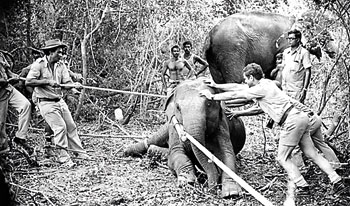“Footfalls in the Wild” is a 403-page collection of the writings of the late Deshabandu Lyn de Alwis. It has been broadly categorized into four sections, the first dealing with some of the writer’s experiences at the National Zoo in Dehiwala, Sri Lanka. The second section mainly describes the writer’s work in Singapore while on secondment from Sri Lanka, primarily to help set up the Zoo there, and ends with the writer’s vision for zoological gardens of the future. The third section covers a variety of aspects of Sri Lankan wildlife, with the final section addressing several aspects of effective wildlife conservation.
 |
One of the first questions to enter a reader’s mind might be, “What do Zoos have to do with the title?” Surprisingly, the answer turns out to be, “Just about everything.” The writer outlines examples of how Zoos, rather than just providing entertainment and education to the general public, perform additional roles that have proven to be crucial in successful wildlife conservation efforts.
The eclectic collection of articles in the book ensures its appeal to a diverse readership. A reader having only a casual interest in wildlife can focus on his/her immediate curiosities and leave reading of the rest for another time. A historian of natural resources conservation will probably find the book to be invaluable for many reasons.
The significant conservation projects described by the writer were undertaken during relatively tumultuous periods in recent Sri Lankan history, when accelerated economic growth became a political priority against a backdrop of persistent infrastructural limitations, severe budgetary restrictions, widespread poaching and a growing threat of terrorism. The commercial benefits of environmental protection and pollution control were not understood by businesses, and in those pre-internet days, the sharing of knowledge between researchers in different parts of the world was more cumbersome, time-consuming, and expensive.
Fortunately, the mistakes in the book are relatively few and mundane, easily corrected in a second edition. It is unfortunate that a few of the articles lack dates, since many of the articles contain mixes of both factual and anecdotal information that future researchers may consider invaluable – especially when studying ecological changes to sanctuaries over progressively longer periods of time.
In sequencing the articles over the four broad categories, the compilers have wisely chosen logical progression over strict adherence to chronology. The photographs, already preserved for several decades, are a welcome bonus. Each reader will choose his/her favourite parts of the book: the stunning “Elephant drive to Wilpattu”; the “theppan” on the Mahawillachchiya tank; “a quiet afternoon in August”; “Singapore’s brush with wild elephants”; “From rainforest to zoological Garden”; the “White Deer” in Yala; “River basin development”; “Ceylon’s first elephant corridor”.
The breadth of subjects addressed by the articles is complemented by the writer’s frequent tendency to delve into minute practical details, and this will probably earn the book a place on the shelf of the dedicated wildlife enthusiast, conservationist, and scholar.
Clearly, this is not a book to be read in a hurry. Secreted in the text are several surprises to reward the diligent reader: the name of the “only place in the world where leopards hunt by day”; when conservation appears to clash with survival; the name of Sri Lanka’s (Ceylon’s) first captive-bred elephant; a picture of a “rare all-male gathering of Ceylon Jungle Fowl.”
Only a few articles need to be read, however, before the overriding theme of the book starts to become clear: the effective conservation of both fauna and flora is an imperative for the survival of humanity. Rather than being a useless agglomeration of frondescence, the writer portrays the jungle (and the fauna that inhabit it) as being a collection of “interdependent … interconnected” “networks of nature” (pp. 325) ranking equal in importance with the crop field and vegetable garden.
Both are critical to the survival of humanity, and the conservationist cannot afford to lose vigilance. A large parcel of the Wilpattu Sanctuary, the writer informs us, was apparently sacrificed to the “Mahawilachchiya Scheme” (pp. 331), while the Udawalawe Sanctuary had to be redeemed from squatters barely seven years after its creation (pp. 263-268). Wasgamuwa, that unique jewel in the crown of Sri Lanka’s Strict Nature Reserves, was threatened with extinction even after the 40 years it took to come into existence (pp. 239-243; 318-319). It is only a matter of time before some irreplaceable natural resource becomes threatened once again, and when that happens, who will save it this time?
Beyond celebrating the life and work of a highly respected individual, the publication of this book gives future generations of leaders the chance to build on past successes and avoid many unnecessary, expensive mistakes. The plenitude of competent, practical, and proven advice proffered to future political leaders, civil administrators, commercial developers, and managers of conservation projects may constitute some of the most powerful lessons that this book has to teach.
The book is available at the Lyn de Alwis Memorial Wildlife Trust, 30 Hotel Road, Mount Lavinia, Barefoot, Odel and other leading bookshops at Rs. 1,500. |



